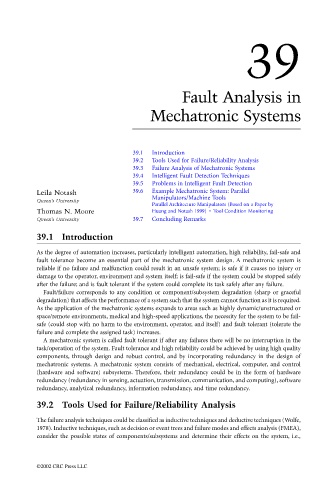Page 1081 - The Mechatronics Handbook
P. 1081
39
Fault Analysis in
Mechatronic Systems
39.1 Introduction
39.2 Tools Used for Failure/Reliability Analysis
39.3 Failure Analysis of Mechatronic Systems
39.4 Intelligent Fault Detection Techniques
39.5 Problems in Intelligent Fault Detection
Leila Notash 39.6 Example Mechatronic System: Parallel
Manipulators/Machine Tools
Queen’s University
Parallel Architecture Manipulators (Based on a Paper by
Thomas N. Moore Huang and Notash 1999) • Tool Condition Monitoring
Queen’s University 39.7 Concluding Remarks
39.1 Introduction
As the degree of automation increases, particularly intelligent automation, high reliability, fail-safe and
fault tolerance become an essential part of the mechatronic system design. A mechatronic system is
reliable if no failure and malfunction could result in an unsafe system; is safe if it causes no injury or
damage to the operator, environment and system itself; is fail-safe if the system could be stopped safely
after the failure; and is fault tolerant if the system could complete its task safely after any failure.
Fault/failure corresponds to any condition or component/subsystem degradation (sharp or graceful
degradation) that affects the performance of a system such that the system cannot function as it is required.
As the application of the mechatronic systems expands to areas such as highly dynamic/unstructured or
space/remote environments, medical and high-speed applications, the necessity for the system to be fail-
safe (could stop with no harm to the environment, operator, and itself) and fault tolerant (tolerate the
failure and complete the assigned task) increases.
A mechatronic system is called fault tolerant if after any failures there will be no interruption in the
task/operation of the system. Fault tolerance and high reliability could be achieved by using high quality
components, through design and robust control, and by incorporating redundancy in the design of
mechatronic systems. A mechatronic system consists of mechanical, electrical, computer, and control
(hardware and software) subsystems. Therefore, their redundancy could be in the form of hardware
redundancy (redundancy in sensing, actuation, transmission, communication, and computing), software
redundancy, analytical redundancy, information redundancy, and time redundancy.
39.2 Tools Used for Failure/Reliability Analysis
The failure analysis techniques could be classified as inductive techniques and deductive techniques (Wolfe,
1978). Inductive techniques, such as decision or event trees and failure modes and effects analysis (FMEA),
consider the possible states of components/subsystems and determine their effects on the system, i.e.,
©2002 CRC Press LLC

